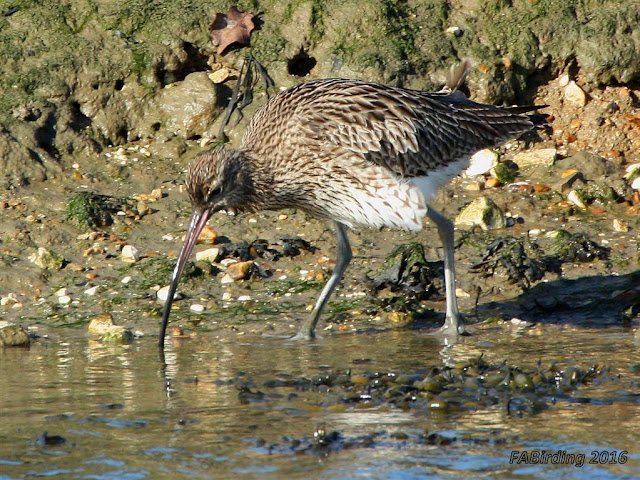For me any visit to a coastal marsh or inter-tidal mudflats would not be the same without the evocative and distinctive rhythmic, rippling flight song or far-carrying whistling "cour-lii" call of our largest wader the [Eurasian] Curlew (Numenius arquata).
During a recent wander, on a very cold and extremely windy morning, around the disused oyster beds on Hayling Island I was fortunate to find this individual in a water filled gully below my feet thus enabling me to get a few images without disturbing its feeding activities.
Its diet is principally invertebrates located by the sensitive bill tip as it constantly probes the mud.
Due to the continued rapid declining trends of its wintering / breeding range and overall population numbers (1969 - 2010) within the European part of its extremely large global range this species is now classed as vulnerable and has now been placed on the 'RED List'. For more information click here.
All images taken 'handheld' with 70-300mm lens plus 1.4x converter. [ISO 400; f/11; 1/320 - 1/400 @ 420mm].
Linking to:
Through My Lens
Nature Notes
Wild Bird Wednesday
Linking to:
Through My Lens
Nature Notes
Wild Bird Wednesday





Fantastic shots!
ReplyDeleteI love coming across these guys on the beach. Nice shots.
ReplyDeleteExcellent!
ReplyDeleteBeautiful! Great "get!"
ReplyDeleteThose are really great results for handheld close-ups. Thank you for linking in with "Through My Lens"
ReplyDeleteMersad
Mersad Donko Photography
That's wonderful, Frank. Must have made your day to be able to spend some time with the curlew.
ReplyDeleteThe relative awfulness of my own shots is beginning to get me down lol
ReplyDeleteThat's sad. When you observe a bird on the RED list, it's a very special moment.
ReplyDeleteHe has quite the long beak.
ReplyDeleteFrank, these photos are awesome but it is your depth of knowledge that "makes" them!...:)JP
ReplyDeleteThis is a fantastic bird to photograph and you did it so well!
ReplyDeleteSooo many birds and other wildlife in trouble and most of it is human caused. Wonderful bird,,,, Michelle
ReplyDeleteHello Frank, thank you for your visit! I leave my comment here, because Eurasian curlew is such an interesting bird. We (Finns) love to hear its call, because it means winter is turning to spring. There is usually a nest rather near our home, but unfortunately there are predators as well in the area.
ReplyDelete